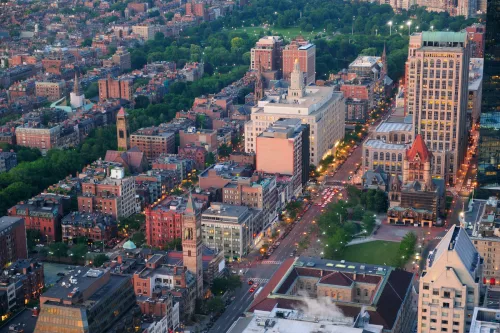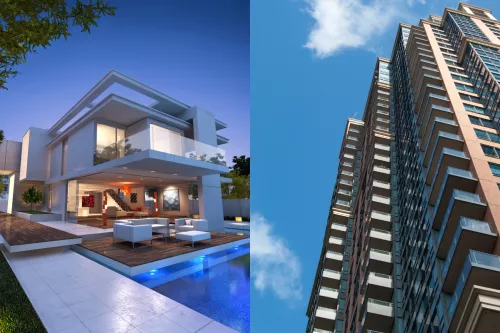Mediterranean-style homes, distinguished by their distinctive architectural and design elements, have become popular in many parts of the world, particularly in areas with climates similar to the Mediterranean coast. Here, we will explore Mediterranean-style homes, their prevalence in certain U.S. states, and the distinct characteristics that distinguish a home as Mediterranean.
What is Mediterranean-Style?
Mediterranean-style homes have their origins in traditional European architecture, heavily influenced by Spanish and Italian designs. These houses are inspired by the quintessential villas found in coastal towns along the Mediterranean, marked by distinctive features like red-tiled roofs, stucco walls, and a harmonious fusion of interior and exterior living spaces.
The style ranges from airy and tranquil to opulent and warm. Essential characteristics include smooth, cool white plaster surfaces, dark wooden beams, luxurious fabrics, and detailed tilework, reflecting the diverse cultural influences that have shaped Mediterranean aesthetics.
Geographical Popularity in the United States
In the United States, Mediterranean-style homes first gained popularity in the 1920s, echoing the haciendas of the Spanish New World with their iconic red tile roofs, arches, and rough plaster similar to plastered adobe. These homes are most commonly found in states with climates and histories that mirror the Mediterranean, such as California and Florida, as well as other Southern states.
Cities like Santa Barbara, Pasadena, Austin, and Miami are known for their concentration of Mediterranean-style homes. The iconic Hearst Castle in San Simeon, California, is a prime example of a Mediterranean mansion, exemplifying the grandeur and elegance of this architectural style.

Defining Features of Mediterranean-Style Homes
When it comes to Mediterranean style homes, atmosphere and living experience are as important, if not more so, than the exterior aesthetic.With features that enhance both the aesthetic appeal and the functionality of the living spaces, these homes are designed to facilitate a comfortable and luxurious lifestyle. The key characteristics of Mediterranean-style homes include:
Red Tile Roofs
These visually striking roofs serve a practical purpose too. Traditionally crafted from clay pots and bricks molded into semi-cylindrical shapes, they are designed to efficiently channel water away.
Stucco Exteriors
Employing stucco for the external walls is a defining feature of Mediterranean-style houses, providing a sleek, long-lasting, and visually attractive finish.
Indoor-Outdoor Living
A key characteristic of Mediterranean homes is the seamless integration of indoor and outdoor areas, typically showcasing interconnected courtyards, patios, and gardens that fluidly extend into the home's interior.
Rich Textiles and Tilework
The inside of Mediterranean homes frequently showcases luxurious fabrics and detailed tile designs, mirroring the cultural impact and artisan skills characteristic of the Mediterranean area.
Wood Beams and Plaster
Incorporating dark wooden beams with smooth white plaster walls is a prevalent element, bringing a sense of warmth and creating a striking contrast within the interior areas.
Architectural Features
The inclusion of arches and similar architectural components that echo historic Mediterranean structures is common in these homes, enhancing their genuine appeal and allure.
There are three main styles of Mediterranean homes:
Italian Renaissance Influence
Inspired by Italian Renaissance architecture, this style is characterized by columns and circular arches.

Spanish Revival Style
Influenced by Spanish colonial architecture, this type of home typically features minimalist, sleek designs and a gently sloping roof.

Contemporary Mediterranean Design
This style retains the classic traits of Mediterranean homes but with a contemporary update. It emphasizes a blend of indoor-outdoor living, open and spacious layouts, and is marked by both Spanish and Italian design elements.

People Also Ask
What is Mediterranean style interior design?
Mediterranean-style design represents a specific form of coastal design, which is more generally influenced by the principles of seaside living. The Mediterranean approach has an allure that can be expressed in both traditional and modern forms, featuring elements like natural stone walls, visible wood beams, or tiled flooring.
Modern Mediterranean architecture features more spacious rooms, larger energy-efficient windows, and contemporary amenities like swimming pools, all while incorporating traditional materials and architectural details.
When discussing Mediterranean style in interior design, professionals typically focus on the visual elements from southern European nations along the Mediterranean Sea, particularly Greece, Italy, and Spain. Yet, with 21 countries bordering the Mediterranean, authentic Mediterranean style can also originate from places like Israel, Morocco, and others.
These Mediterranean nations often incorporate aspects of each other's designs, united by their common connection to the Mediterranean Sea. Each country has its own rich history of cultural and design traditions spanning many centuries.

 Marcio Vasconcelos
Marcio Vasconcelos





